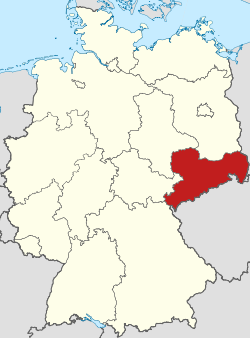
Saxony
State in Germany / From Wikipedia, the free encyclopedia
Dear Wikiwand AI, let's keep it short by simply answering these key questions:
Can you list the top facts and stats about Free State of Saxony?
Summarize this article for a 10 year old
Saxony,[lower-alpha 1] officially the Free State of Saxony,[lower-alpha 2] is a landlocked state of Germany, bordering the states of Brandenburg, Saxony-Anhalt, Thuringia, Bavaria, as well as the countries of Poland and the Czech Republic. Its capital is Dresden, and its largest city is Leipzig. Saxony is the tenth largest of Germany's sixteen states, with an area of 18,413 square kilometres (7,109 sq mi), and the sixth most populous, with more than 4 million inhabitants.
Free State of Saxony
| |
|---|---|
| Anthem: Sachsenlied [de] | |
 | |
| Coordinates: 51°1′37″N 13°21′32″E | |
| Country | Germany |
| Capital | Dresden |
| Largest city | Leipzig |
| Government | |
| • Body | Landtag of Saxony |
| • Minister-President | Michael Kretschmer (CDU) |
| • Governing parties | CDU / Greens / SPD |
| • Bundesrat votes | 4 (of 69) |
| • Bundestag seats | 38 (of 736) |
| Area | |
| • Total | 18,415.66 km2 (7,110.33 sq mi) |
| Population (31 December 2018) | |
| • Total | 4,077,937 |
| • Density | 220/km2 (570/sq mi) |
| Demonym | Saxon |
| GDP | |
| • Total | €146.511 billion (2022) |
| • Per capita | €35,909 (2022) |
| Time zone | UTC+1 (CET) |
| • Summer (DST) | UTC+2 (CEST) |
| ISO 3166 code | DE-SN |
| NUTS Region | DED |
| HDI (2021) | 0.933[2] very high · 8th of 16 |
| Website | www |
The state is also home to a minority of Sorbs, a West Slavic ethnic group native to the area, numbering an estimated 80,000 people.[3]
The term Saxony has been in use for more than a millennium. It was used for the medieval Duchy of Saxony, the Electorate of Saxony of the Holy Roman Empire, the Kingdom of Saxony, and twice for a republic. The first Free State of Saxony was established in 1918 as a constituent state of the Weimar Republic. After World War II, it was under Soviet occupation before it became part of communist East Germany and was abolished by the government in 1952. Following German reunification, the Free State of Saxony was reconstituted with enlarged borders in 1990 and became one of the five new states of the Federal Republic of Germany.
The area of the modern state of Saxony should not be confused with Old Saxony, the area inhabited by Saxons. Old Saxony corresponds roughly to the modern German states of Lower Saxony, Saxony-Anhalt, and the Westphalian part of North Rhine-Westphalia.


